╔
Atene, dove l’ulivo è più di un albero
L’olio d’oliva è uno degli ingredienti onnipresenti della tradizione culinaria mediterranea. Non c’è piatto che non ne preveda l’utilizzo, sia a crudo per insaporire o conservare a lungo i cibi, sia cotto per i soffritti o le fritture. Ma da dove arriva questo ingrediente, così familiare alle popolazioni del Mediterraneo da considerarlo un elemento autoctono di ogni paese?
Sulla base di ritrovamenti fossili e archeologici, si stima che l’ulivo sia originario dell’Asia Minore e sia stato coltivato per la prima volta in Anatolia (oggi parte della Turchia). Da qui, si è poi diffuso nelle regioni costiere del Mediterraneo, dall’Italia alla Spagna, fino alla Tunisia e alla Siria, trasportato a bordo delle navi dagli infaticabili mercanti fenici.
Adattandosi perfettamente ai climi caldi e secchi di queste zone, i suoi frutti e l’olio da questi derivato sono entrati da protagonisti nelle cucine dei popoli che si affacciano sul bacino del Mediterraneo. La sua versatilità in cucina e il suo profilo salutistico hanno fatto sì che l’olio d’oliva fosse celebrato non solo come un ingrediente base, ma anche come un simbolo della “Dieta Mediterranea”, patrimonio culturale immateriale dell’umanità riconosciuto dall’UNESCO nel 2010.
Olive oil is a must ingredient in the Mediterranean culinary tradition. There is hardly any dish that does not include the use of olive oil, either raw for seasoning and long-term storage, or cooked for frying. Well, question is: where does this ingredient, so familiar to the many Mediterranean populations to consider it an element native of all countries?
Based on a fossils and archaeological findings, it is estimated that the olive tree is originally from Asia Minor and it was first cultivated in Anatolia (today part of Turkey). Since then, it has spread in the coastal countries of the Mediterranean Sea, from Italy to Spain, all the way to Turkey and Syria, traveling onboard of tireless Phoenician ships.
Perfectly adapting to the warm and dry climate of these countries, olives and olive oil have become main characters of the cooking of populations living by the Mediterranean basin. Its versatility in the kitchen and its healthy properties have made olive oil not just a base ingredient, but also a symbol of the “Mediterranean Diet”, cultural immaterial patrimony of humanity as recognized by the UNESCO in 2010.
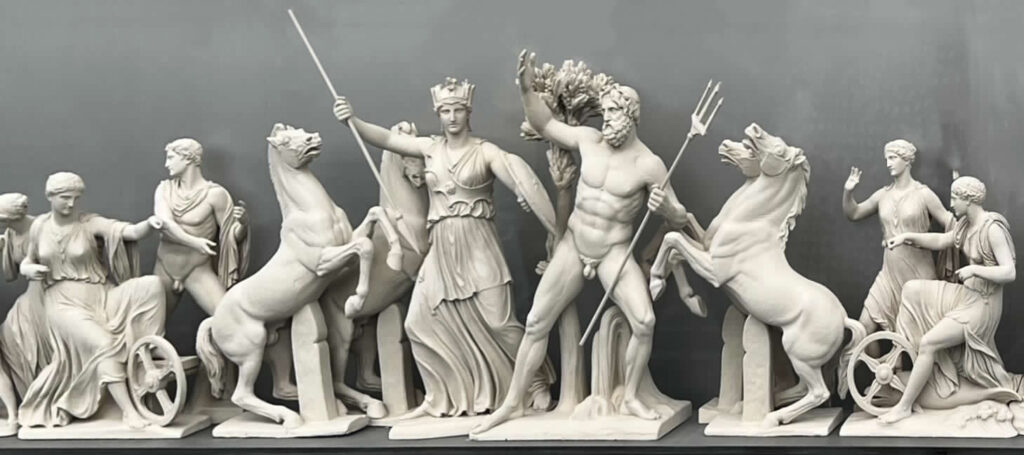
Atena e Poseidone si contendono il protettorato di Atene. Particolare della ricostruzione del frontone occidentale del Partenone, Atene, Museo dell’Acropoli. (Fotografia: A. Badami).
Athena and Poseidon compete for the protectorate of Athens. Detail of the reconstruction of the western pediment of the Parthenon, Athens, Acropolis Museum. (Photo: A. Badami).
Se la ricerca scientifica ci porta a queste conclusioni, la contro-storia narrata dalla mitologia greca rivendica invece la paternità di questo straordinario ingrediente. Secondo la mitologia greca, l’ulivo fu un dono della dea Atena alla città di Atene. Il mito tramanda che, durante una competizione con il dio Poseidone per stabilire quale delle due divinità avesse il diritto di essere la protettrice della città, Atena offrì un ulivo come regalo alla popolazione. Il suo albero, simbolo di pace e abbondanza, risultò più utile per gli ateniesi rispetto alla donazione di Poseidone, che aveva offerto una sorgente salata, considerata meno utile. Grazie alla saggezza della dea, l’ulivo divenne un simbolo di prosperità per la città di Atene e fu piantato in numerosi luoghi sacri e pubblici. Ancora oggi questo mito fondativo, immortalato da Fidia nel frontone occidentale del Partenone (come testimoniato da Pausania [Paus. 1.24.5]), viene mantenuto vivo con la presenza di un albero di ulivo ai piedi dell’Eretteo sull’Acropoli di Atene (non allarmatevi: non è quello dell’età degli dei dell’Olimpo! Ogni tanto, viene sostituito con una pianta più giovane).
Scientific research leads us to the above-mentioned conclusions; however, an antagonistic story told by the Greek mythology claims paternity of this extraordinary ingredient. According to the Greek mythology, the olive tree was a gift of the Goddess Athena to the city of Athens. Mythology hands down that, during a competition with God Poseidon to establish which one of the two divinities would have had the right to be the patron of the city, Athena offered an olive tree as a gift to the population. The tree, symbol of peace and abundance, was considered more useful to the Athenians compared to the gift received from Poseidon, who chose a salty wellspring instead. Thanks to the wisdom of Athena, the olive tree soon began a symbol of prosperity for the city of Athens and was planted in many sacred and public places. Nowadays, this myth regarding the origin of the olive tree, immortalized by Fidia on the west pediment of the Parthenon (as witnessed by Pausania [Paus. 1.24.5]), is maintained alive by the presence of an olive tree at the base of the Erechtheion, on top of the Acropolis of Athens (no worries: the actual tree is not the same as the one at the time of the Gods of Mount Olympus! Every now and again, the tree is replaced by a younger one).
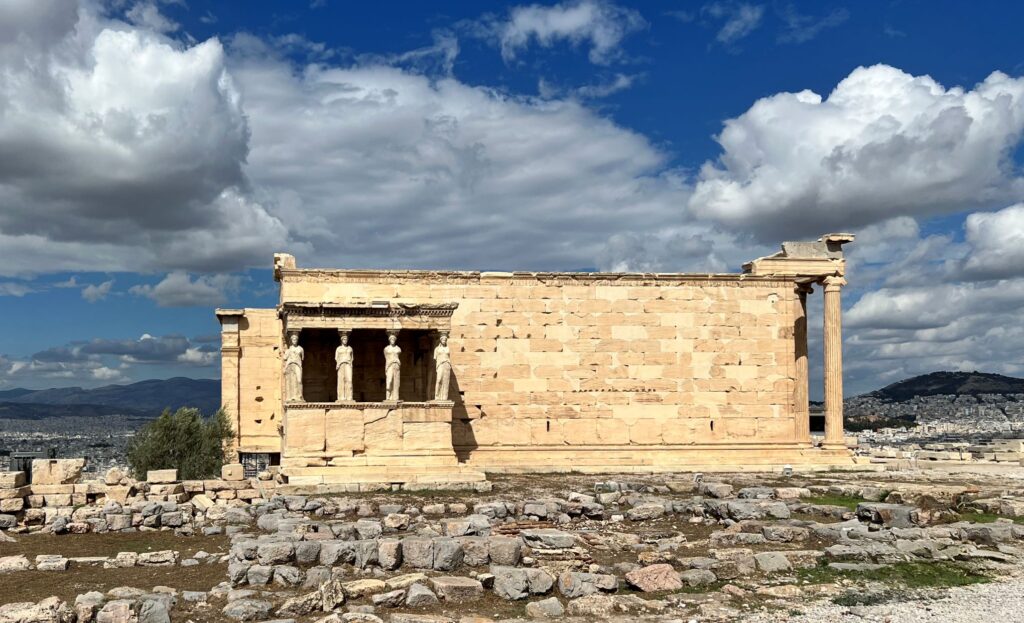
Eretteo, Acropoli di Atene. A sinistra, ai piedi del tempio, è piantato un albero di ulivo. (Fotografia: A. Badami).
Erechtheion, Acropolis of Athens. On the left, at the foot of the temple, an olive tree is planted. (Photo: A. Badami).
Come in molti paesi mediterranei, in Grecia l’olio d’oliva è l’ingrediente base per cucinare, friggere e condire. I greci consumano l’olio d’oliva in ogni pasto: dai piatti più semplici come l’insalata greca, preparata con pomodori, cetrioli, cipolle, feta e olive, al famoso tzatziki, una salsa a base di yogurt e cetriolo, all’esotica babaganoush, la crema a base di polpa di melanzana, tahina e menta, fino ai piatti più elaborati come la moussaka e il souvlaki. L’olio è presente persino nei dolci, come la baklava, realizzata con strati di pasta fillo ripieni di noci tritate, zucchero, chiodi di garofano e cannella che ricevono una ricca spruzzatina di olio d’oliva caldo prima della cottura.
As for many Mediterranean countries, in Greece olive oil is a base ingredient for cooking, frying and seasoning. Greeks consume a lot of olive oil at every meal: in simple dishes like Greek salad, prepared with tomatoes, cucumbers, onions, feta cheese and olive, in the most famous tzatziki, a dip made with yogurt and cucumber, or the exotic babaganoush, a cream made with aubergine, tahini and mint. Olive oil is also used in the more elaborated dishes such as moussaka and souvlaki. Oli is also used to make dessert like the baklava, made with layers of filo pastry filled with crushed hazelnuts, sugar, cloves and cinnamon finished with a gentle spray of warm olive oil before baking.
Souvlaki, spiedino di carne grigliata insaporito con una marinatura di succo di limone, olio extravergine di oliva ed erbe aromatiche, accompagnato dalla pita, il tradizionale pane greco, patate al forno e insalata. (Fotografia: A. Badami).
Souvlaki, a skewer of grilled meat seasoned with a marinade of lemon juice, extra virgin olive oil and aromatic herbs, accompanied by pita, the traditional Greek bread, baked potatoes and salad. (Photo: A. Badami).
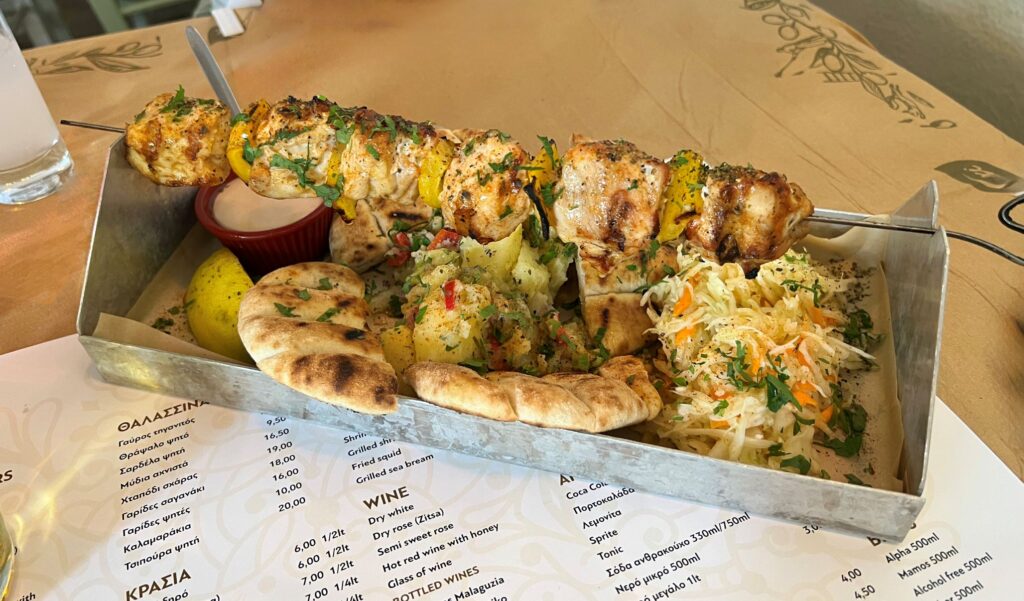
In Grecia, e specialmente ad Atene, l’olio d’oliva non è solo un ingrediente o un rimedio terapeutico e cosmetico: è diventato un elemento iconico della tradizione. Simboli dell’ulivo sono dappertutto: rami d’ulivo incoronavano le teste di atleti, generali e re vittoriosi; foglie di ulivo erano rappresentate sul tetradramma ateniese; con l’olio di oliva si ungevano i corpi degli atleti prima delle competizioni alle olimpiadi. Ma lo troviamo ancora, in versione viva e vegeta, lungo i viali alberati della città, nelle aiuole, nei parchi gioco per bambini, nelle scuole, nei giardini privati e pubblici.
Uno degli esempi più suggestivi della connessione tra Atene e l’ulivo è il Giardino del Centro Culturale Stavros Niarchos, uno degli spazi pubblici più innovativi della capitale greca realizzato nel 2016 su progetto di Renzo Piano. A Kallithea, a 4 km a sud del centro di Atene, dove prima insisteva un’area urbana dismessa, sede dapprima di un ippodromo e poi inclusa nell’area dei Giochi Olimpici del 2004, si apre un grande giardino inclinato di 170.000 mq dove abitano piante mediterranee caratteristiche del territorio dell’Attica, come lavanda, rosmarino, timo e centinaia di ulivi; una parte del parco è dedicata agli orti mentre un grande campo di graminacee conduce ad un terrazzo panoramico.
In Greece, and especially in Athens, olive oil is not just an ingredient or a therapeutic or cosmetic remedy: it has become an iconic element of tradition. Symbols of the olive tree can be found anywhere: olive tree branches were used to crown heads of athletes, army generals and victorious kings; olive leaves were represented on the Athenian tetradrachm; olive oil was used to oil athletes bodies before Olympic competitions. Also, olive trees can be found along the main roads of the city, in flowerbeds, in children’s playgrounds, in school, private and public gardens.
One of the most suggestive connections between Athens and the olive tree is the garden of the Cultural Center Stavros Niarchos, one of the most innovative public areas of the Greek capital, realized in 2016 under the guidance of the famous Italian Architect Renzo Piano. In Kallithea, 4Km south of Athens, there used to be a demolished urban area, formerly a racecourse which was later on included in the area of the Olympic games of 2004; here it opens a big inclined garden measuring 170.000 squares meters where Mediterranean plants typical of the territory of Attica, such as lavender, rosemary, thyme, and hundreds of olive trees… of course! One area of the park is dedicated to vegetable garden, while, a big grass field decorates a panoramic terrace.
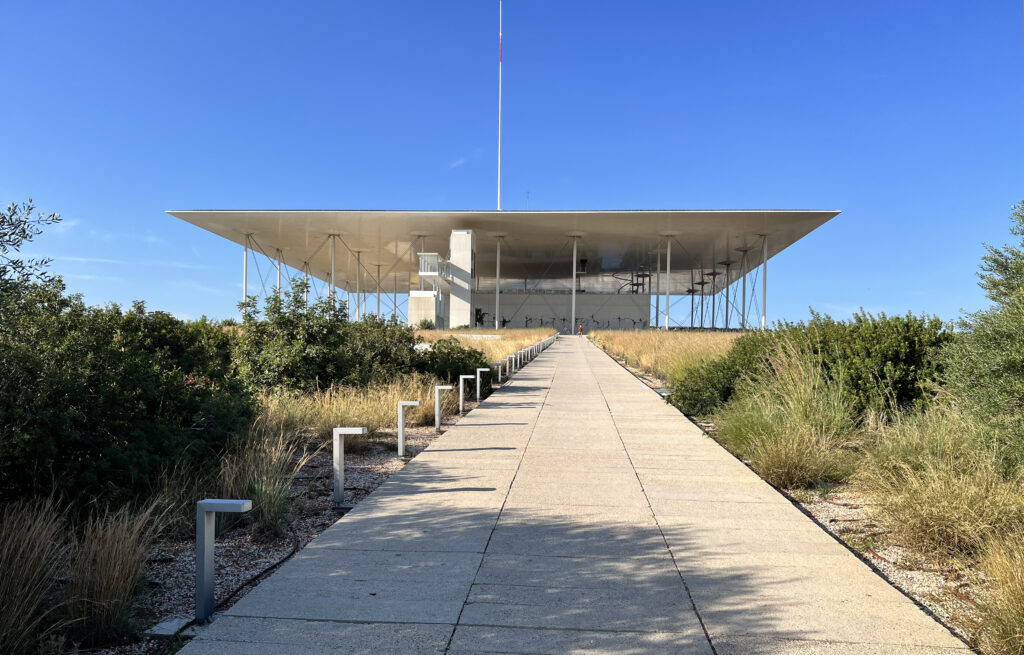
Tetto giardino e terrazzo panoramico del Centro Culturale della Fondazione Stavros Niarchos. (Fotografia: A. Badami).
Roof garden and panoramic terrace of the Stavros Niarchos Foundation Cultural Center. (Photo: A. Badami).
Solo dopo esserci persi in una passeggiata immersi nella natura, tra le fragranze delle piante aromatiche e suggestivi scorci naturalistici, ci accorgiamo che il giardino non è uno spazio antistante l’edificio ma è, in effetti, il tetto dell’edificio stesso. I sei piani che si sviluppano al di sotto del giardino ospitano l’Opera Nazionale Greca e la Biblioteca Nazionale della Grecia, mentre dal terrazzo posto sulla sommità del giardino inclinato una vista panoramica ristabilisce la connessione visiva tra l’Acropoli e il mare, restituendo a Kallithea (in greco: “bella vista”) il suo originario significato etimologico.
It is just after getting lost during a walk in the wild nature, overcome by the fragrances of aromatic plants and the suggestive naturalistic landscapes, that we acknowledge that the garden is not just a mere area standing in front of the of the main building, but we are amazed realizing that it actually is the roof of the building itself! The building has six floors developing below the rooftop garden, where the National Greek Opera house and the National Library of Greece are hosted, whereas from the rooftop terrace, sitting on top of the inclined garden, a panoramic view re-establishes the visual connection between the Acropolis and sea, giving back to Kallithea (translated from Greek : ”belvedere”) its original etymologic meaning.
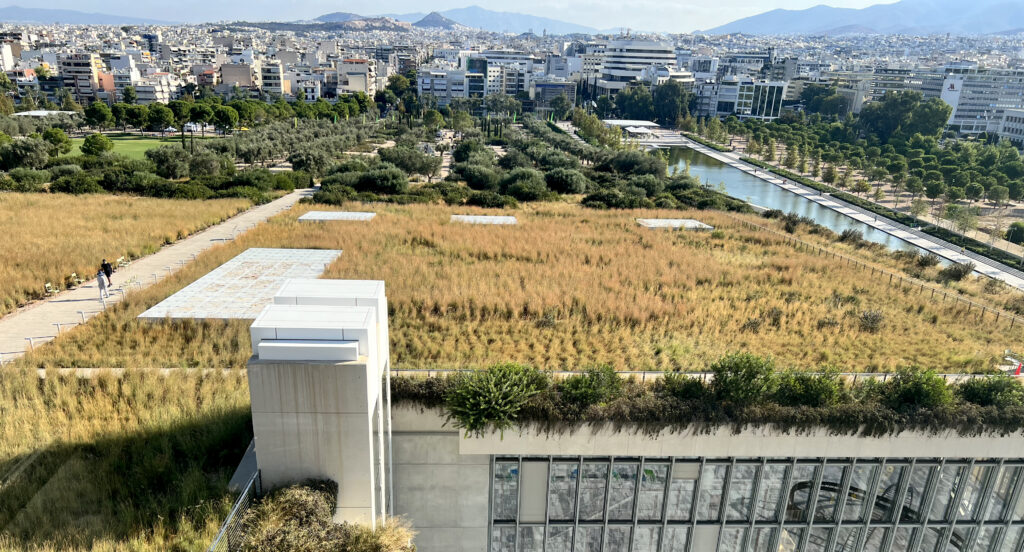
Tetto giardino del Centro Culturale della Fondazione Stavros Niarchos. (Fotorgrafia: A. Badami).
Roof garden of the Stavros Niarchos Foundation Cultural Center. (Photo: A. Badami).
Il centro, importante polo culturale e sociale per la città e per l’intero paese, e riuscitissimo compendio di arte, natura e spazio pubblico, rende omaggio alla storia e alla mitologia della città con il suo giardino, dominato da alberi di ulivo carichi di polpose olive, rappresentando al contempo il simbolo di un futuro più sostenibile e inclusivo per la città di Atene.
The center, an important cultural and social hub for the city and the entire country and exquisite quintessence of art, nature and public area, pays homage to history and to the myths of the city thanks to its garden, dominated by the olive trees and their loads of juicy olives, representing at the same time a symbol of a more sustainable and inclusive future for the city of Athens.
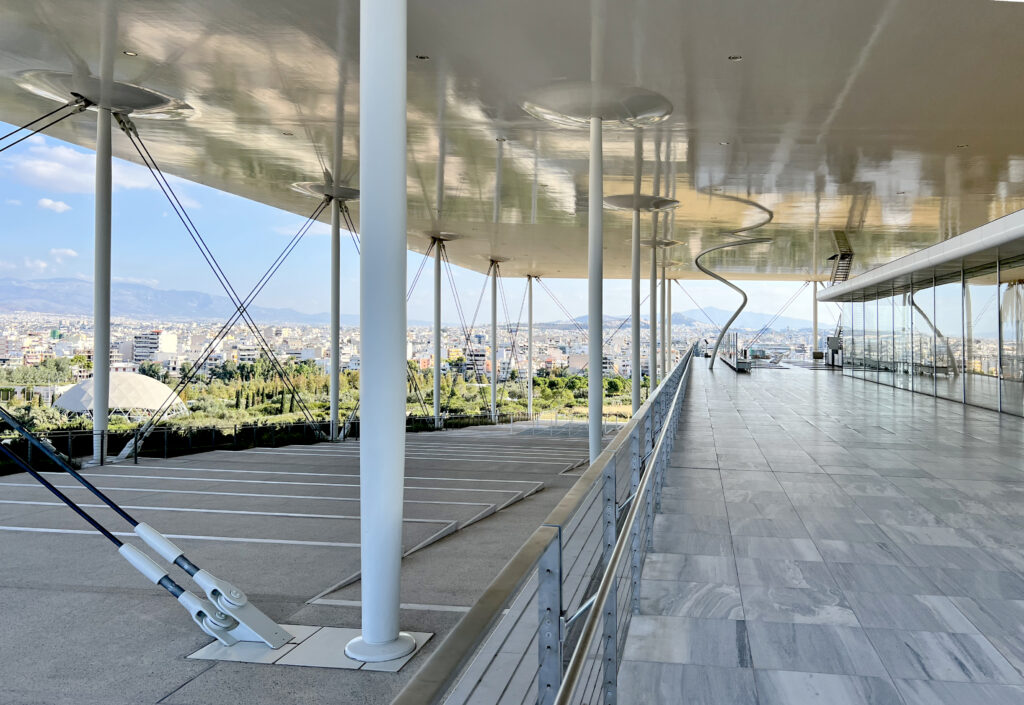
Terrazzo panoramico del Centro Culturale della Fondazione Stavros Niarchos con vista sull’Acropoli di Atene. (Fotografia: A. Badami).
Panoramic terrace of the Stavros Niarchos Foundation Cultural Center with a view of the Acropolis of Athens. (Photo: A. Badami).
Translation by Ester Badami
IMMAGINE INIZIALE | Stavros Niarchos Foundation Cultural Center, Kallithea, a sud di Atene. Progetto di Renzo Piano Building Workshop. (Foto: A. Badami).
HEAD IMAGE | Stavros Niarchos Foundation Cultural Center, Kallithea, south of Athens. Project by Renzo Piano Building Workshop. (Photo: A. Badami).